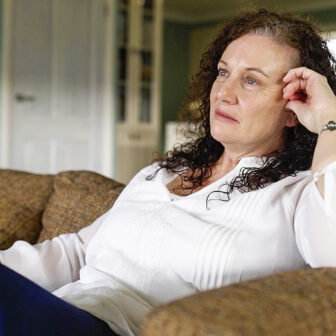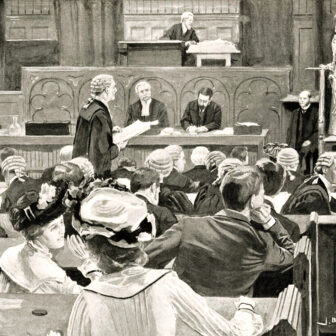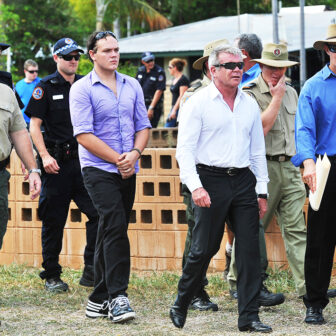During the time I worked as a criminal defence lawyer I acted regularly for a teenage girl, “Angel,” whose home life was marked by constant interruption. Bullied by her peers, abused and neglected at home, Angel found what she took for acceptance among older men who, unfortunately for her, often had extensive criminal histories. “Kyle” was one such man, and while she was with him he assaulted and robbed a middle-aged man. The victim spent weeks in hospital, and Kyle went to jail. But because Angel hadn’t done anything to stop him, and had run away with him afterwards, police charged her as an accessory. The children’s court wanted her to participate in a group conference – a controlled discussion that includes the victim and aims to address the reasons why a child is breaking the law – before it sentenced her.
There were great hopes for the conference, and in the days leading up to it Angel was suffering extreme anxiety. On the day, though, the person sitting in Angel’s victim’s place was representative from a victims’ rights organisation, who told us that the victim was too traumatised to meet his attackers. I wondered what demon his mind had made of Angel, the slim, nervous fifteen-year-old girl sitting beside me. Also present was Angel’s mother, myself as Angel’s lawyer, Angel’s youth justice worker, an educational officer, a police officer and the convener.
Unfortunately, the victims’ rights representative was only interested in using the conference as a platform to berate and shame Angel for her (rather passive) role in the horrific attack. The convener was unable to steer the conference in such a direction that the underlying factors in Angel’s pattern of offending – her unstable home life, her lack of school attendance because of severe bullying there, and her related drug use – could be discussed in any meaningful way. Angel’s mother was more concerned to wash her hands of the girl’s behaviour.
The conference was deeply unsatisfactory, though Angel’s participation was taken into account by the court, which ultimately imposed a slightly lesser penalty than it might otherwise have done. In part because every assessment of Angel’s situation was conducted in the presence of her mother, the conferencing process also missed its opportunity to link Angel with appropriate services to help her cut back on drugs, cope with her anxiety and get back into education. And because the victim chose not to participate, the group conference missed the opportunity to contribute to the victim’s healing process as well.
But victims do participate personally in about half of all conferences. And as imperfect as it often is in practice, group conferencing does have a proven track record of reducing recidivism among young offenders and leaving participants satisfied with its work.
In Victoria, group conferencing was just one of a series of radical reforms to the criminal justice system during Rob Hulls’s time as attorney-general between 1999 and 2010. Besides group conferencing for young offenders (introduced in 2003), Hulls oversaw the introduction of Koori courts (in 2002), a drug court pilot (also 2002), Collingwood’s Neighbourhood Justice Centre (2007) and Melbourne’s Assessment and Referral Court List (2010). On leaving government, he established the Centre for Innovative Justice at RMIT.
Hulls is a sweary, passionate man with a booming voice, who gives the impression he could talk at you until he converts you. It was his experiences representing legal-aid clients in both Victoria and Queensland that propelled him into political office, first as the federal member for what’s now Bob Katter’s seat in Queensland, and then in his home state from 1996.
“You need to believe what you’re saying,” he tells me with urgency, “and you need to explain your ideas clearly. You need to spend a lot of time with journalists, getting them to understand what you’re doing, and you need to write opinion pieces to explain yourself to the public. And when you do get something through, you need stacks of independent assessment to show it’s bloody well working.”
And working it is. Koori courts have been shown to cut recidivism rates in half. The Neighbourhood Justice Centre also showed immediate benefits. The Dandenong drug court saves the Victorian government about $5.80 for every dollar it spends on it. As well as reducing the likelihood that participants will offend again, it has also been found to reduce unemployment among participants by a third.
Hulls’s reforms aren’t unique in Australia. The first Nunga court was established at Port Adelaide in mid 1999 without any specific legislative basis, as an initiative of a magistrate, Chris Vass, and community groups, police and the Aboriginal Legal Rights Movement. “Circle sentencing” began for Indigenous offenders in 2002 in New South Wales, and Murri courts and Aboriginal community courts were established in 2006 in Queensland and Western Australia respectively. The first drug court began operations in Sydney in 1999, and similar courts now sit in Victoria, Western Australia, Queensland and South Australia. And mental health courts, of which the Assessment and Referral Court List is one, can also be found in Queensland, South Australia and Tasmania.
Indigenous-specific sentencing courts adapt sentencing circle practices seen in Canada and New Zealand, and are among the first real acknowledgements by Australian criminal courts of the ways in which they’ve been complicit in the long colonial history of Aboriginal and Torres Strait Islander dispossession. They aim to address directly the sense of alienation with which many Aboriginal offenders experience not merely court systems, but also much of life. While they don’t yet have room for victims, by slowing down the sentencing process Koori courts in Victoria, for instance, allow a more meaningful exchange between the offender and the magistrate. By sitting on specific days every month, the court can more readily coordinate with local services (drug and alcohol counselling; grief counselling; anger management and offender behaviour programs; education and training): when representatives of services are in the courtroom, it’s much easier for magistrates to direct defendants to link up with them. And, crucially, by involving Elders from the local Koori community, the court offers opportunities for community re-engagement, pastoral care and genuine shaming that just don’t happen in a classically structured court. Whereas a plea in a mainstream court might take five minutes, the same hearing in a Koori court may take up to an hour – or even longer.
Koori courts are often difficult emotional experiences for people pleading guilty to crimes, because they’re asked to reflect on their behaviour and answer to their Elders – or are reintroduced to a community from which they’ve become estranged. They’re also difficult for magistrates, who come down from the bench – which functions as a kind of emotional barrier to the effects of their decisions on offenders – to sit at the bar table directly opposite the defendant. Magistrates often say they find Koori court sitting days the most consistently challenging of all hearing days. “I sweat buckets, and I finish completely emotionally drained,” one told me. Having sat on Koori courts since their inception, Clive Alsop of the Gippsland circuit can often be seen editorialising from the bench about their extraordinary benefits to anyone who may be listening.
Circle sentencing in NSW local courts goes a step further than Victoria’s Koori courts by involving local Koori and Ngunnawal communities and Elders in decisions about how to sentence Aboriginal people who commit crimes. Victoria’s Koori courts explicitly keep Elders out of sentencing decisions so that they can’t be seen to have participated in a decision to imprison an Aboriginal person, though magistrates and Elders often discuss cases behind closed doors.
Again, though, these alternative sentencing models aren’t magic solutions to the problems of criminality and dysfunction. Indigenous courts are notoriously open to the “deep colonising” critique advanced by UNSW academic Deborah Bird Rose in 1996 to describe processes – like the granting of limited land rights – that ostensibly advance the cause of decolonisation, but whose effects in practice further the colonial project by incorporating merely the least threatening of the anti-colonialists’ demands.
Whereas Koori courts are intended to incorporate limited aspects of Koori culture and community in an effort to address the overwhelming alienation experienced by many Indigenous people in the Victorian court systems, anecdotal evidence exists to suggest that they may have a divisive effect on some Koori communities. I’ve had many conversations with people who tell me they resent the insider/outsider divisions fostered by the court.
“Those Koori court Elders who sit there and don’t do anything to stop us mob getting locked up,” one Gunai-Kurnai woman said to me, “they’re just as bad as them trackers a hundred years ago.” One man who has worked within the Koori courts told me he’s concluded that it’s just a “sneaky whitefella way of getting Kooris through a racist system.”
The Koori court model is a specialist court incorporating aspects of restorative and therapeutic justice, but the court itself is established by people untrained in any therapeutic profession: a magistrate, a prosecutor, a corrections officer, a court officer and two community Elders. Where a problem-solving or therapeutic approach is required, sometimes the court runs off-course – and Koori courts have been known to lose patience when people come back a second or third time without showing any improvement in behaviour. Constructive shaming, which is one of the intended elements of Elder involvement in Koori courts, isn’t always appropriate.
After her inadequate group conference, fifteen-year-old Angel hadn’t begun to engage any more successfully with services that might be able to help her, in part because nobody yet had any real idea about what might be driving her to hang around twenty-something men with long criminal records. So when she was arrested again and brought before the Koori court, the Elders laid the shame, guilty and responsibility on thick. For an hour, they told her what a thorough disappointment she was to her family and to the community, what a disrespectful child she was, how much pain she’d put everyone through, and that they didn’t think they had anything more to offer her. I watched Angel’s face during this sixty-minute roasting. It was blank, as I imagined it was when her family laid into her for her various failings.
We later commissioned a psychologist to assess Angel. In his report, he noted her tendency to dissociate – to detach herself from her own emotional state – when the pain would otherwise be too intense. Had the court been more attuned to this psychological possibility – and Angel is hardly unique in this respect – it could have attempted to engage her in ways other than the failed strategies employed by her family. Following the Koori court hearing, I asked Angel how she felt. “That talk doesn’t scare me,” she said. “I get it all the time and I just ignore it.”
The NSW Bureau of Crime Statistics and Research’s examination of circle sentencing in New South Wales, and other restorative justice sentencing practices has convinced its director, Don Weatherburn, that they don’t work to reduce recidivism. (The bureau’s findings about circle sentencing contradict the assessments of Victoria’s Koori courts in reducing recidivism.) Indeed, Weatherburn makes a forceful argument in his latest book, Arresting Incarceration (2014), that spending on restorative justice practices such as conferences, sentencing circles and specialist Aboriginal courts actually diverts much-needed resources away from tackling criminality’s true antecedents: dysfunctional families and peer networks.
Advocates of the Koori court model in Victoria counter Weatherburn’s argument by pointing to the fact that there are therapeutic benefits to Koori court sentencing: the additional time allocated to sentencing discussions puts magistrates in more of a mood to consider sentencing options tailored to rehabilitative ends; Koori courts can take more of a pastoral interest in offenders by deferring their final sentence while they engage in pre-sentence rehabilitation programs; and because many of the Koori-specific services have representatives in court on allocated Koori court days, appropriate pre- and post-sentence options are more visible and available to magistrates than in mainstream court hearings, where a premium is placed on moving cases along quickly.
Aboriginal courts, drug courts, the Assessment and Referral Court List and the Neighbourhood Justice Centre are all functioning examples of what’s known as therapeutic jurisprudence. Unlike the classical criminal justice model, which is mostly concerned with establishing guilt or innocence and aims to punish the offender’s “choice” to behave criminally, therapeutic jurisprudence accepts that certain kinds of disadvantage – drug dependency, mental illness and brain damage – are strikingly implicated in offending behaviour. Working on the assumption that criminality for dysfunctional people is a symptom of their dysfunction, therapeutically oriented courts aim to address that dysfunction with intensive intervention over a period of months or years. •
This is an edited extract from Crime and Punishment: Offenders and Victims in a Broken Justice System, by Russell Marks, published by Redback




